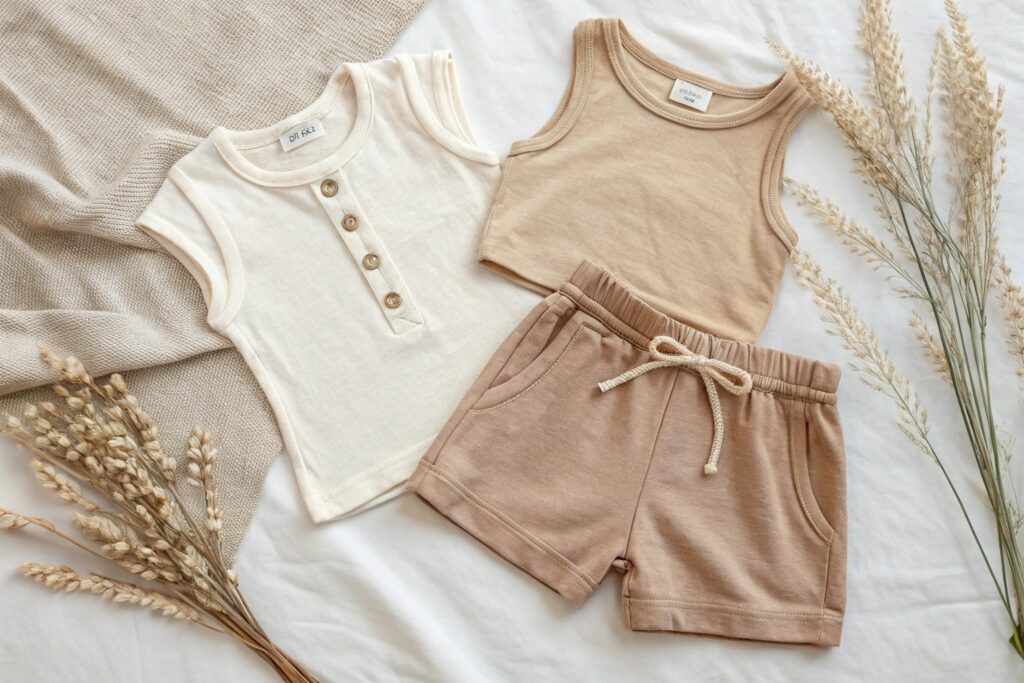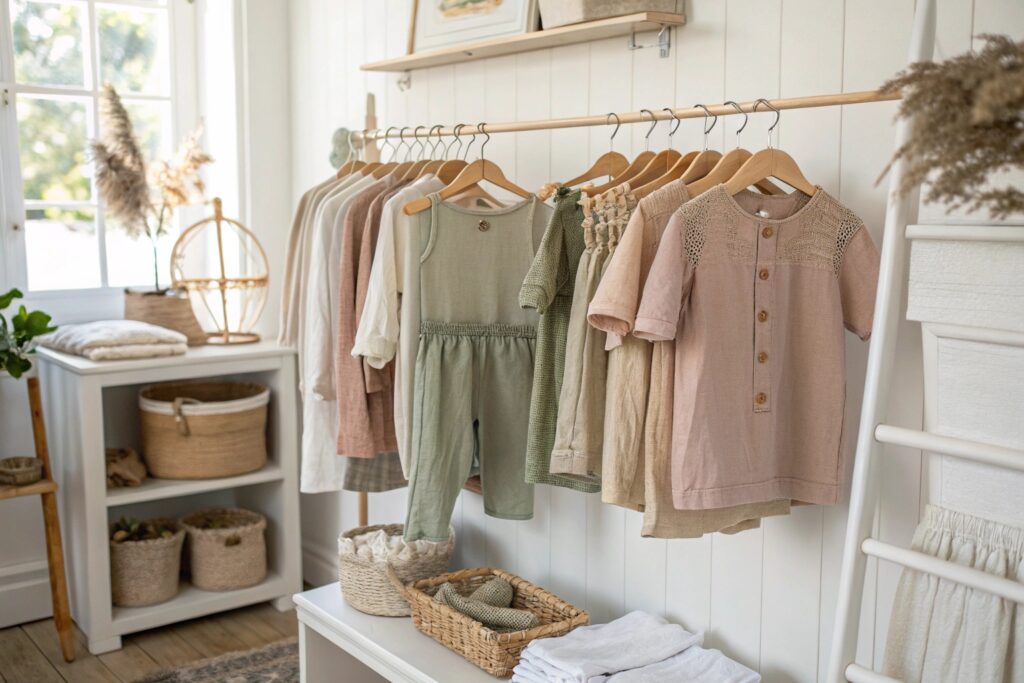Parents today are overwhelmed by choices, clutter, and clothes their kids barely wear once—so brands are responding with less, not more.
Children’s fashion brands are embracing minimalist style to reduce waste, improve versatility, and align with parents’ growing demand for practical, timeless, and sustainable clothing.
Minimalism in kidswear is more than a trend—it’s a strategic shift toward what matters: comfort, quality, and calm.
Benefits of Minimalist Style in Kids’ Clothing
In a market flooded with bright prints and novelty designs, simplicity stands out—and stays relevant.
Minimalist kidswear focuses on clean lines, neutral tones, and timeless cuts, making outfits easier to mix, longer to wear, and less likely to be returned or discarded.

How does minimalist fashion make dressing children easier for parents and kids?
Getting kids dressed shouldn’t be a daily battle. With minimalist capsules, every item pairs with the others. Fewer distractions and loud prints mean less negotiation and fewer tears.
We work with brands that build small seasonal collections (10–15 SKUs) using neutral palettes like clay, sage, cream, and denim. These not only reduce decision fatigue for parents, but empower kids to dress themselves without clashing colors or complicated fasteners.
At Fumao Clothing, we offer matching sets designed with flat seams and stretch-friendly cuffs, making them both easy to wear and comfortable for long play hours.
Why does minimalist design enhance the longevity and reusability of kidswear?
Minimalist pieces avoid trendy graphics, licensed characters, or seasonal slogans. That means they don’t go out of style—and can be worn by younger siblings or passed on to friends.
One of our clients introduced a minimalist capsule with soft terracotta and off-white tones. Two years later, those same designs are still their top resale items on secondhand platforms.
Neutral, clean garments live longer. They grow with the child—and the family.
How Minimalism Helps Cut Overproduction Waste
Mass production creates excess inventory, markdowns, and waste. Minimalist fashion helps brands slow down, produce with precision, and sell smarter.
Minimalist fashion reduces waste by simplifying product lines, extending selling seasons, and allowing brands to forecast more accurately without chasing fleeting trends.

What role does minimalist design play in improving inventory efficiency?
Minimalist collections require fewer colorways, fewer prints, and fewer size-specific tweaks—making them easier to batch-produce and easier to scale sustainably.
Here’s a quick comparison we often share with partners:
| Approach | SKUs / Season | Avg. Sell-Through | Leftover Inventory |
|---|---|---|---|
| Trend-Driven Fashion | 80–120 | 60% | 40% |
| Minimalist Capsules | 10–25 | 85–95% | 5–15% |
At Fumao Clothing, we help brands plan minimalist lines with smart MOQ strategies and mixable sizing (e.g., 2–3Y, 4–5Y). One European partner reported their end-of-season unsold inventory dropped from 30% to just 7% after switching to a minimalist capsule.
Less waste. More margin. Stronger brand trust.
Why do minimalist lines perform better on resale and circular platforms?
Minimalist kidswear holds value longer. Solid neutrals, clean cuts, and quality fabrics appeal across parent preferences and work for all genders.
We’ve seen brands like ours thrive on resale platforms because their capsule pieces avoid “dated” looks. Plus, fewer items mean families take better care of each one.
By focusing on wearability instead of novelty, minimalist fashion extends each garment’s lifecycle—reducing both physical and economic waste.
Why Parents Prefer Simplified Kidswear Designs
Today’s parents aren’t just shopping for cute—they’re looking for ease, function, and values that match their own.
Simplified kidswear designs appeal to modern parents who prioritize quality, sensory comfort, and minimal visual noise in their children’s wardrobes.

How does minimalist design improve comfort and function for kids?
Many kids, especially those with sensory sensitivities, find traditional kidswear overwhelming. Loud prints, scratchy tags, and overcomplicated layers can cause discomfort.
Minimalist clothing often features:
- Seamless construction
- Natural, breathable fabrics
- Tagless labeling
- Soft elastic bands and cuffs
- Simple pull-on silhouettes
We’ve helped several brands develop organic cotton basics with flatlock seams and soft dyes. Parents of sensory-sensitive children report higher satisfaction and repeat purchases.
Less visual clutter also helps children stay focused—ideal for play, school, or calm routines.
Why do minimalist brands enjoy stronger customer loyalty among families?
Minimalist collections create trust. When every piece feels useful, parents return—not just for clothes, but for the peace of mind they bring.
One of our clients includes capsule styling cards with their orders—showing parents 12 ways to mix the 6 pieces. Customers appreciate that level of support. It makes them feel confident, not confused.
Simplification is a service. When brands help parents simplify life, they win loyalty.
Minimalist Trends in European Kids’ Fashion
Europe has long led the charge on child-focused, sustainable fashion—and minimalism is at the heart of that movement.
From Scandinavia to Southern Europe, minimalist kidswear trends emphasize muted tones, clean cuts, eco fabrics, and a design philosophy rooted in function and beauty.

What countries and designers are leading minimalist kidswear globally?
Here are a few key regions and their standout characteristics:
| Region | Aesthetic Traits | Sample Brands |
|---|---|---|
| Scandinavia | Earth tones, gender-neutral, wool blends | Minimalisma, Konges Sløjd |
| France | Soft neutrals, effortless layering | Petit Bateau, Emile et Ida |
| Spain/Portugal | Linen textures, soft pastels | 1+ in the family, My Little Cozmo |
These brands often prioritize organic cotton, ethical manufacturing, and slow fashion releases. The result is less marketing hype—and more long-term brand love.
At Fumao Clothing, we’ve helped clients create collections inspired by these trends, combining Nordic simplicity with durable construction tailored for international markets.
How can emerging brands incorporate European minimalism into their kidswear?
You don’t need to be in Copenhagen to build a Scandinavian-inspired line. Focus on:
- Reducing your color palette to 3–5 core shades
- Using only 1 or 2 silhouettes per category
- Swapping cartoon prints for textural detail
- Offering clean, logo-free basics
We support brands with template-ready minimalist tech packs, low-MOQ production, and child-safe finishing options that work for EU and U.S. compliance.
Minimalism isn’t about plainness. It’s about meaning—what stays when everything else is stripped away.
Conclusion
Minimalist fashion isn’t just a design choice—it’s a business strategy, a parenting solution, and a step toward sustainability. In children’s clothing, less truly can be more.










